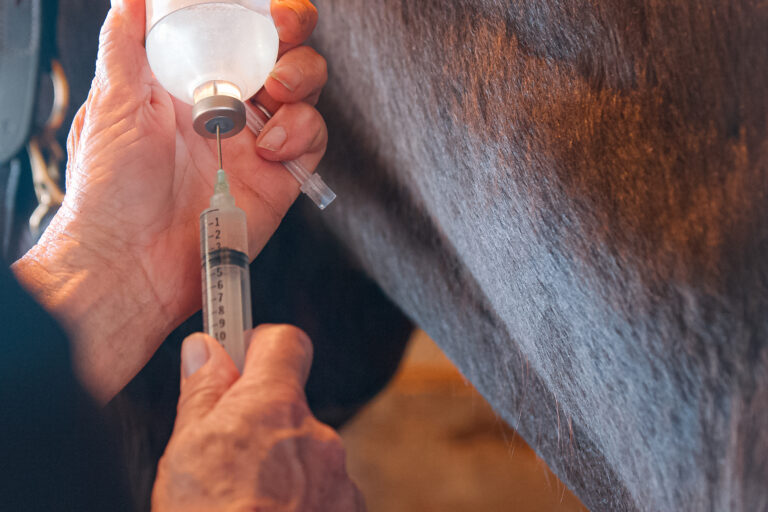
Climate change has led to more frequent and severe wildfires. During a wildfire, smoke dissipates hundreds of miles, which can have significant health consequences for all species, including humans and horses. At the 2024 ACVIM Conference, Katie Sheats, DVM, PhD, DACVIM (LAIM), FHEA, Associate Professor at North Carolina State University, presented on how wildfire smoke (WFS) exposure impacts equine lower airways.
Wildfire Particulate Matter
Wildfires emit small particle matter that adversely affects the respiratory tract. Sheats reported that 92% of the world’s population lives in areas where air quality levels exceed World Health Organization limits, leading to more than 6.5 million human deaths worldwide each year. As a result of poor air quality conditions, many humans now suffer from increased asthma, increased susceptibility to viral infections, reduced lung function, chronic obstructive pulmonary disease (COPD), lung cancer, chronic bronchitis, and emphysema. Horses are breathing the same air and are likely similarly affected.
Particulate matter (PM) size affects penetration into the airways. PM 10 particles deposit in the upper airways and trachea, while respirable dust PM 5 and fine particles PM 2.5 are the most important components of exposure, penetrating deeper into the respiratory tract. Ultrafine particles can reach into the alveoli and even cross the respiratory epithelium into the circulation. PM 2.5 or smaller are not visible.
Equine Asthma
Equine asthma is similar to human asthma, particularly with regard to respiratory tract wall remodeling. In the Northern Hemisphere, 10-20% of adult horses experience severe asthma, with 80% of racehorses and more than 20% of sport horses having mild or moderate asthma. Immunogenic triggers for equine asthma include endotoxin, beta-glucan from fungal cell walls, barn and hay dust, stall bedding, summer pasture, and mold. Wildfire smoke, increased heat and humidity, and other sources of air pollution further degrade a horse’s respiratory health.
Effects of Wilfire Smoke on Exposed Mice
Some wildfires and prescribed burns emit 90% of particles as PM 2.5. In a 2008 study on mice in California, toxic particulate matter elicited a dose response of neutrophils as seen in BAL fluid. In response to smoke, neutrophils, chemokines, and cytokines climbed, while macrophages and antioxidant concentrations decreased.
Effects of Wilfire Smoke on Exposed Horses and Cows
After a peat bog wildfire in North Carolina in 2008, researchers examined cardiopulmonary toxicity in exposed horses. Lung inflammation developed from PM 10 size particles. Inflammation was attenuated by treatment with polymyxin B, thereby demonstrating lipopolysaccharide (LPS) contribution to inflammation. In 2021, Holstein cows that were fine on Day 0 experienced decreased total white blood cell counts and decreased serum amyloid on Days 2-4 after exposure to WFS with PM 2.5 coupled with a high temperature and humidity index. During those days, cough, ocular discharge, heart rate, and respiratory rate increased in cows and calves. Another group of lactating dairy cows in Idaho had lower milk yields and altered milk fatty acids for seven days.
Researchers in Ontario, Canada, examined 78 horses with preexisting equine asthma between 2007-2017. They recorded weekly mean values of air quality index (AQI), PM 2.5, nitrous oxide, ozone, and temperature for four weeks prior to BAL evaluation. Air with PM 2.5 and nitrous oxide were associated with respective 11-24% greater risk of increased granulocytes in the lower airways.
Another study in Canada (2019) looked at the speed performance of 12 previously healthy polo ponies with long-term exposure from ongoing bush fires near Calgary. The horses developed coughs, and their performance declined. Tracheal mucus scores, aerobic capacity, and speed worsened until particulates in air quality improved by Day 20. These horses did not benefit from dexamethasone treatment.
In collaboration with the Center for Environmental Medicine, Asthma, and Lung Biology in Chapel Hill, North Carolina, Sheat’s lab evaluated six horses with paired samples during the 2023 influx of smoke from Canadian wildfires. Within 24-72 hours, there were significant changes in lower airway cytology and protein expressions of BAL cell transcriptome and supernatant proteome. During the four days of wildfire smoke, the AQI was > 101, and PM 2.5 and PM 10 concentrations, nitrous oxide, carbon monoxide, and ozone all increased. Interestingly, those horses showed no increase in spontaneous cough, rebreathing, nasal discharge, or BAL cellularity. She suggests this might be due to lag periods and timing of evaluation or the type of smoke.
Precautions for Horses Exposed to Wildfire Smoke
In summary, Sheats recommends taking the following precautions when horses are exposed to wildfire smoke:
- Limit strenuous activity.
- Provide plenty of fresh water.
- Limit dust exposure by feeding low-dust feed.
- Give sufficient time to recover from smoke exposure.
- Adjust activity depending on AQI data. Concentrations of wildfire smoke PM 2.5 are available at www.fire.airnow.gov.
Related Reading
- Impact of Steamed Hay and Alfalfa Pellets on Severe Equine Asthma
- Diagnosing Respiratory Ailments in Horses: Wash or Lavage?
- Electrical Impedance Tomography: A Promising Imaging Modality
Stay in the know! Sign up for EquiManagement’s FREE weekly newsletters to get the latest equine research, disease alerts, and vet practice updates delivered straight to your inbox.

![[Aggregator] Downloaded image for imported item #19123](https://s3.amazonaws.com/wp-s3-equimanagement.com/wp-content/uploads/2025/12/22164801/GettyImages-825125882-1-scaled-1-768x512.jpg)
![[Aggregator] Downloaded image for imported item #18374](https://s3.amazonaws.com/wp-s3-equimanagement.com/wp-content/uploads/2025/09/30140012/EDCC-Unbranded-28-scaled-1-768x512.jpeg)

